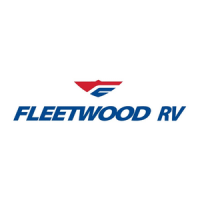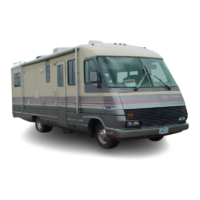Living
With
Your
Motor
Home
perate climate. The best growth occurs at tem-
peratures between
40°F and
lOO°F.
Most impor-
tantly, mold growth requires moisture, and
moisture is the only growth factor that can be
controlled. By minimizing interior sources
of
moisture, an
RV
owner can reduce or prevent
mold growth. However,
if
optimal growth con-
ditions persist, mold can develop within 24 to
48 hours.
Moisture in the
RV
can stem from a variety
of
sources such
as
spills, leaks, overflows, conden-
sation, damp
or
standing water and human
activity such
as
showering or cooking. Good
maintenance practices are essential
in
the effort
to prevent or reduce mold growth.
What the RV Owner Can Do
The
RV
owner can take positive steps to reduce
the occurrence
of
mold growth in the
RV
and
thereby minimize any possible adverse effects
that may be caused by mold.
These steps may include, but are not limited to,
the following:
• Before bringing items into the
RV
check
for signs
of
mold. Potted plants (root and
soil), furnishings, or stored clothing and
bedding materials may also contain mold
spores.
• Regular vacuuming and cleaning will help
reduce levels
of
settled mold spores.
Additionally, detergent solutions and most
tile cleaners are effective in controlling
mold growth on surfaces.
• Keep the humidity in the
RV
below 40%.
Ventilate kitchens and bathrooms by open-
ing windows, using exhaust fans, or mn-
ning the air conditioning to remove excess
moisture in the air and to facilitate evapo-
ration
of
water from wet surfaces. In gen-
eral, windows or doors through out the
RV
should be opened periodically to ventilate
the
RY.
• Promptly clean up spills, condensation, and
other sources
of
moisture. Thoroughly dry
any wet surfaces or material. Do not let
06-10
water pool
or
stand in or under your
RV.
• Inspect for leaks on a regular basis. Look
for discolorations or wet spots. Repair any
leaks promptly. Inspect condensation pans
(refrigeration and air conditioners) for
mold growth. Take notice
of
musty odors
and any visible signs
of
mold growth.
Other actions the
RV
owner can take to prevent
moisture issues include the following:
• Do NOT use unvented propane, kerosene,
or other unvented combustion heaters;
• Do NOT cover or close off the floor regis-
ters (if equipped);
•
Check:
your cooling equipment filter on a
monthly basis;
• Use the air conditioner or a dehumidifier
during humid months, particularly during
the summer in hot, humid climates;
• Use exhaust fans in kitchen and bathrooms
to remove excess moisture;
• Clean the bathroom with mold-killing
products
For more information about mold, and what you
can do to reduce moisture and remediate mold
growth in your
RV,
please refer to the following
websites and literature;
1.
U.S. Environmental Protection Agency.
'Mold Remediation in Schools and
Commercial Buildings
2001.
http://www.epa.govliaq/molds/moldremediation html
2.
U.S. Environmental Protection Agency.
A Brief Guide
to
Mold, Moisture, and Your
Home,2002.
http://www.epa.govliaq/molds/moldquide.html
FIRE SAFETY
The hazard and possibility
of
fire exists in all
m'eas
of
life, and the recreational life-style
is
no
exception. Your
RV
is
a complex machine made
up
of
many materials, some
of
them flmumable.
But like most hazards, the possibility
of
fire can
be minimized, if not totally eliminated:by recog-
li--------'-
1;""---

